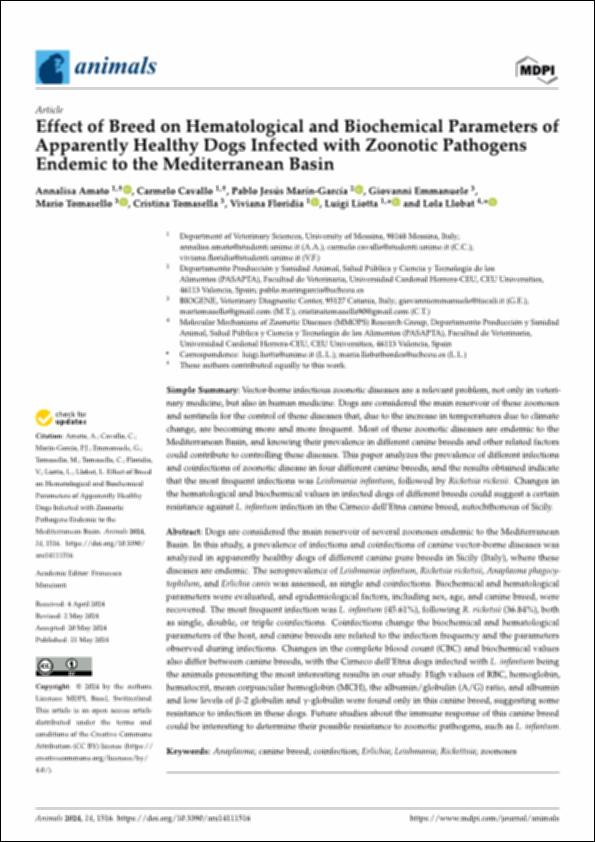Please use this identifier to cite or link to this item:
http://hdl.handle.net/10637/15908Effect of breed on hematological and biochemical parameters of apparently healthy dogs infected with zoonotic pathogens endemic to the Mediterranean Basin
| Title: | Effect of breed on hematological and biochemical parameters of apparently healthy dogs infected with zoonotic pathogens endemic to the Mediterranean Basin |
| Authors : | Amato, Annalisa Cavallo, Carmelo Marín García, Pablo Jesús Emmanuele, Giovanni Tomasello, Mario Tomasella, Cristina Floridia, Viviana Liotta, Luigi Llobat Bordes, Lola |
| Keywords: | Perros; Dogs; Zoonosis; Zoonoses; Leishmaniasis; Animals vectors; Animales vectores; Animal diseases; Enfermedad animal; Immunology; Inmunología |
| Publisher: | MDPI |
| Citation: | Amato, A., Cavallo, C., Marín-García, P.J., Emmanuele, G., Tomasello, M., Tomasella, C., Floridia, V., Liotta, L. & Llobat, L. (2024). Effect of breed on hematological and biochemical parameters of apparently healthy dogs infected with zoonotic pathogens endemic to the Mediterranean Basin. Animals, vol. 14, i. 11, art. 1516 (21 may.). DOI: https://doi.org/10.3390/ani14111516 |
| Abstract: | Dogs are considered the main reservoir of several zoonoses endemic to the Mediterranean Basin. In this study, a prevalence of infections and coinfections of canine vector-borne diseases was analyzed in apparently healthy dogs of different canine pure breeds in Sicily (Italy), where these diseases are endemic. The seroprevalence of Leishmania infantum, Ricketsia ricketsii, Anaplasma phagocytophilum, and Erlichia canis was assessed, as single and coinfections. Biochemical and hematological parameters were evaluated, and epidemiological factors, including sex, age, and canine breed, were recovered. The most frequent infection was L. infantum (45.61%), following R. ricketsii (36.84%), both as single, double, or triple coinfections. Coinfections change the biochemical and hematological parameters of the host, and canine breeds are related to the infection frequency and the parameters observed during infections. Changes in the complete blood count (CBC) and biochemical values also differ between canine breeds, with the Cirneco dell’Etna dogs infected with L. infantum being the animals presenting the most interesting results in our study. High values of RBC, hemoglobin, hematocrit, mean corpuscular hemoglobin (MCH), the albumin/globulin (A/G) ratio, and albumin and low levels of β-2 globulin and γ-globulin were found only in this canine breed, suggesting some resistance to infection in these dogs. Future studies about the immune response of this canine breed could be interesting to determine their possible resistance to zoonotic pathogens, such as L. infantum. |
| URI: | http://hdl.handle.net/10637/15908 |
| Rights : | http://creativecommons.org/licenses/by/4.0/deed.es Open Access |
| ISSN: | 2076-2615 (Electrónico) |
| Issue Date: | 21-May-2024 |
| Center : | Universidad Cardenal Herrera-CEU |
| Appears in Collections: | Dpto. Producción y Sanidad Animal, Salud Pública Veterinaria y Ciencia y Tecnología de los Alimentos |
Items in DSpace are protected by copyright, with all rights reserved, unless otherwise indicated.


